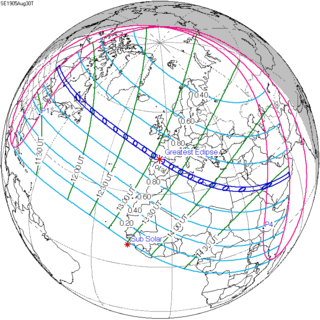Solar eclipse of August 30, 1905
| Solar eclipse of August 30, 1905 | |
|---|---|
| Type of eclipse | |
| Nature | Total |
| Gamma | 0.5708 |
| Magnitude | 1.0477 |
| Maximum eclipse | |
| Duration | 226 s (3 min 46 s) |
| Coordinates | 42°30′N 4°18′W / 42.5°N 4.3°W |
| Max. width of band | 192 km (119 mi) |
| Times (UTC) | |
| Greatest eclipse | 13:07:26 |
| References | |
| Saros | 143 (17 of 72) |
| Catalog # (SE5000) | 9293 |
A total solar eclipse occurred on August 30, 1905. A solar eclipse occurs when the Moon passes between Earth and the Sun, thereby totally or partly obscuring the image of the Sun for a viewer on Earth. A total solar eclipse occurs when the Moon's apparent diameter is larger than the Sun's, blocking all direct sunlight, turning day into darkness. Totality occurs in a narrow path across Earth's surface, with the partial solar eclipse visible over a surrounding region thousands of kilometres wide. Totality was visible from Canada, Newfoundland Colony (now belonging to Canada), Spain, French Algeria (now Algeria), French Tunisia (now Tunisia), Ottoman Tripolitania (now Libya) include the capital Tripoli, Egypt, Ottoman Empire (the parts now belonging to Saudi Arabia) including Mecca, Emirate of Jabal Shammar (now belonging to Saudi Arabia), Aden Protectorate (now belonging to Yemen), and Muscat and Oman (now Oman).
This eclipse was observed from Alcalà de Xivert in Spain.[1] It was also observed by members of the British Astronomical Association from various locations.[2]
Related eclipses
Solar eclipses of 1902–1907
This eclipse is a member of a semester series. An eclipse in a semester series of solar eclipses repeats approximately every 177 days and 4 hours (a semester) at alternating nodes of the Moon's orbit.[3]
The partial solar eclipses on May 7, 1902 and October 31, 1902 occur in the previous lunar year eclipse set, and the partial solar eclipse on July 21, 1906 occurs in the next lunar year eclipse set.
| Solar eclipse series sets from 1902 to 1906 | ||||||
|---|---|---|---|---|---|---|
| Descending node | Ascending node | |||||
| Saros | Map | Gamma | Saros | Map | Gamma | |
| 108 | April 8, 1902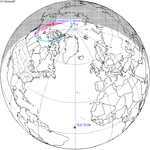 Partial |
1.5024 | 113 | October 1, 1902 | ||
| 118 | March 29, 1903 Annular |
0.8413 | 123 | September 21, 1903 Total |
−0.8967 | |
| 128 | March 17, 1904 Annular |
0.1299 | 133 | September 9, 1904 Total |
−0.1625 | |
| 138 | March 6, 1905 Annular |
−0.5768 | 143
|
August 30, 1905 Total |
0.5708 | |
| 148 | February 23, 1906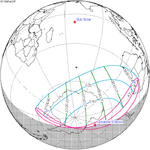 Partial |
−1.2479 | 153 | August 20, 1906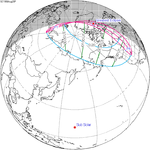 Partial |
1.3731 | |
Solar 143
This eclipse is a part of Saros series 143, repeating every 18 years, 11 days, and containing 72 events. The series started with a partial solar eclipse on March 7, 1617. It contains total eclipses from June 24, 1797 through October 24, 1995; hybrid eclipses from November 3, 2013 through December 6, 2067; and annular eclipses from December 16, 2085 through September 16, 2536. The series ends at member 72 as a partial eclipse on April 23, 2897. Its eclipses are tabulated in three columns; every third eclipse in the same column is one exeligmos apart, so they all cast shadows over approximately the same parts of the Earth.
The longest duration of totality was produced by member 16 at 3 minutes, 50 seconds on August 19, 1887, and the longest duration of annularity will be produced by member 51 at 4 minutes, 54 seconds on September 6, 2518. All eclipses in this series occur at the Moon’s ascending node of orbit.[4]
| Series members 12–33 occur between 1801 and 2200: | ||
|---|---|---|
| 12 | 13 | 14 |
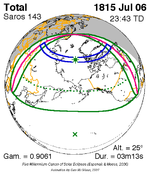 July 6, 1815 |
 July 17, 1833 |
 July 28, 1851 |
| 15 | 16 | 17 |
 August 7, 1869 |
 August 19, 1887 |
 August 30, 1905 |
| 18 | 19 | 20 |
 September 10, 1923 |
 September 21, 1941 |
 October 2, 1959 |
| 21 | 22 | 23 |
 October 12, 1977 |
 October 24, 1995 |
 November 3, 2013 |
| 24 | 25 | 26 |
 November 14, 2031 |
 November 25, 2049 |
 December 6, 2067 |
| 27 | 28 | 29 |
 December 16, 2085 |
 December 29, 2103 |
 January 8, 2122 |
| 30 | 31 | 32 |
 January 20, 2140 |
 January 30, 2158 |
 February 10, 2176 |
| 33 | ||
 February 21, 2194 | ||
Inex series
This eclipse is a part of the long period inex cycle, repeating at alternating nodes, every 358 synodic months (≈ 10,571.95 days, or 29 years minus 20 days). Their appearance and longitude are irregular due to a lack of synchronization with the anomalistic month (period of perigee). However, groupings of 3 inex cycles (≈ 87 years minus 2 months) comes close (≈ 1,151.02 anomalistic months), so eclipses are similar in these groupings. In the 19th century:
- Solar saros 140: total solar eclipse of October 29, 1818
- Solar saros 141: annular solar eclipse of October 9, 1847
- Solar saros 142: total solar eclipse of September 17, 1876
| Inex series members between 1901 and 2100: | ||
|---|---|---|
 August 30, 1905 (Saros 143) |
 August 10, 1934 (Saros 144) |
 July 20, 1963 (Saros 145) |
 June 30, 1992 (Saros 146) |
 June 10, 2021 (Saros 147) |
 May 20, 2050 (Saros 148) |
 May 1, 2079 (Saros 139) |
||
In the 22nd century:
- Solar saros 150: partial solar eclipse of April 11, 2108
- Solar saros 151: annular solar eclipse of March 21, 2137
- Solar saros 152: total solar eclipse of March 2, 2166
- Solar saros 153: annular solar eclipse of February 10, 2195
Notes
- ^ Fabricio Cardenas, Vieux papiers des Pyrénées-Orientales, Eclipse solaire de 1905 à Perpignan, 20 March 2015
- ^ British Astronomical Association; Levander, Frederick William (1906). The total solar eclipse 1905 : Reports of observations made by members of the British Astronomical Association of the total solar eclipse of 1905, August 30. University of California Libraries. London : British Astronomical Association.
- ^ van Gent, R.H. "Solar- and Lunar-Eclipse Predictions from Antiquity to the Present". A Catalogue of Eclipse Cycles. Utrecht University. Retrieved October 6, 2018.
- ^ "NASA - Catalog of Solar Eclipses of Saros 143". eclipse.gsfc.nasa.gov.
References
- Earth visibility chart and eclipse statistics Eclipse Predictions by Fred Espenak, NASA/GSFC
- The total solar eclipse 1905: Reports of observations made by members of the ... By British Astronomical Association, Frederick William Levander
- Report of the solar eclipse expedition to Palma, Majorca, August 30, 1905 ... By Solar Physics Committee, Norman Lockyer
- Sketchs of Solar Corona August 30, 1905
- Sketchs from Russia expedition for solar Corona August 30, 1905 (2)

